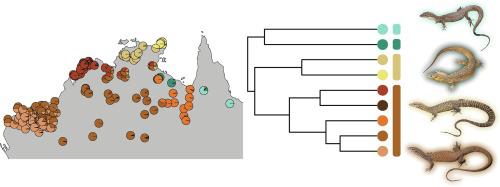Molecular Phylogenetics and Evolution ( IF 3.6 ) Pub Date : 2022-05-14 , DOI: 10.1016/j.ympev.2022.107516 Carlos J Pavón-Vázquez 1 , Damien Esquerré 1 , Alison J Fitch 2 , Brad Maryan 3 , Paul Doughty 3 , Stephen C Donnellan 4 , J Scott Keogh 1

|
Genomic data are a powerful tool for the elucidation of evolutionary patterns at the population level and above. The combined analysis of genomic and morphological data can result in species delimitation hypotheses that reflect evolutionary history better than traditional taxonomy or any individual source of evidence. Here, we used thousands of single nucleotide polymorphisms, mitochondrial sequences, and comprehensive morphological data to characterize the evolutionary history of the ridge-tailed monitors in the Varanus acanthurus complex (V. acanthurus, V. baritji, and V. storri), a group of saxicolous lizards with a wide distribution in Australia, the driest vegetated continent. We found substantial genetic structure in the group and identify nine geographically clustered populations. Based on admixture patterns and species delimitation analyses we propose a taxonomic scheme that differs from current taxonomy. We consider V. acanthurus as monotypic, synonymize V. baritji with V. a. insulanicus (as a redefined V. insulanicus), elevate the subspecies of V. storri to full species (V. storri and V. ocreatus), and describe a new species from a previously identified center of endemism. The relationships among the species remain unresolved, likely as a result of fast speciation. Our study highlights the capability of large datasets to illuminate admixture patterns, biogeographic history, and species limits, even when phylogeny is not completely resolved. Furthermore, our results highlight the impact that the Cenozoic aridification of Australia had on saxicolous taxa and the role of mesic rocky escarpments as refugia. These habitats apparently allowed the persistence of lineages that became sources of colonization for arid environments.
中文翻译:

在岩石和干燥的地方之间:脊尾监测器的系统基因组学、生物地理学和系统学(Squamata: Varanidae: Varanus acanthurus complex)
基因组数据是阐明种群水平及以上进化模式的有力工具。基因组和形态学数据的综合分析可以产生比传统分类学或任何个体证据来源更好地反映进化历史的物种划界假设。在这里,我们使用了数千个单核苷酸多态性、线粒体序列和综合形态学数据来描述棘尾巨蜥复合体(V. acanthurus、V. baritji和V. storri中脊尾监视器的进化历史。),一群蜥蜴,广泛分布于澳大利亚这个植被最干燥的大陆。我们在该组中发现了大量的遗传结构,并确定了九个地理聚集的种群。基于混合模式和物种划界分析,我们提出了一种不同于当前分类的分类方案。我们考虑V。acanthurus作为单型,同义词V。baritji与V。一个。insulanicus(作为重新定义的V . insulanicus),提升V的亚种。storri到完整的物种 ( V . storri和V。 _ ocreatus),并描述了一个来自先前确定的特有中心的新物种。物种之间的关系仍未解决,可能是快速物种形成的结果。我们的研究强调了大型数据集阐明混合模式、生物地理历史和物种限制的能力,即使系统发育没有完全解决。此外,我们的研究结果强调了澳大利亚新生代干旱化对 saxicolous 类群的影响以及中质岩石悬崖作为避难所的作用。这些栖息地显然允许谱系的持续存在,这些谱系成为干旱环境的殖民来源。





















































 京公网安备 11010802027423号
京公网安备 11010802027423号